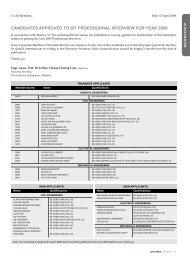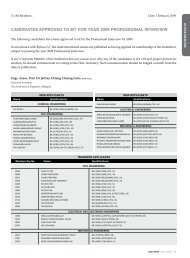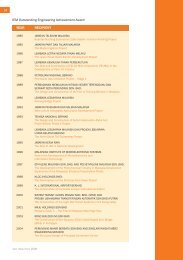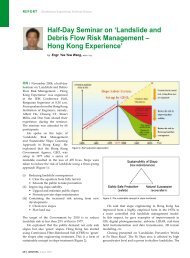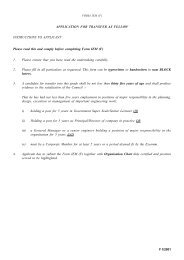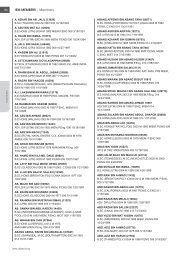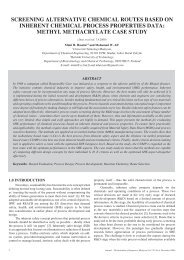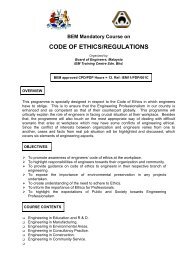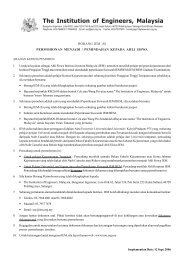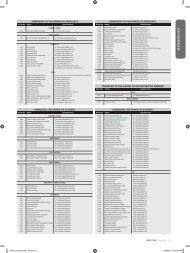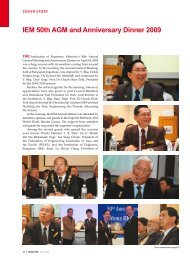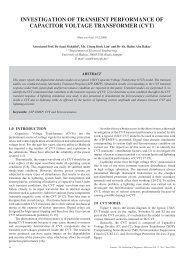candidates approved to sit professional interview for year 2009
candidates approved to sit professional interview for year 2009
candidates approved to sit professional interview for year 2009
Create successful ePaper yourself
Turn your PDF publications into a flip-book with our unique Google optimized e-Paper software.
eport<br />
Half-Day Seminar on High Per<strong>for</strong>mance Concrete and<br />
Concrete Structure Relining<br />
by Engr. Neo Boon Kheng, MIEM, P. Eng.<br />
Chemical Engineering Technical Division feature report<br />
Tunnelling and Underground Space Technical Division<br />
The Tunnelling and Underground Space Technical Division,<br />
of The Institution of Engineers, Malaysia had organised a halfday<br />
seminar on High Per<strong>for</strong>mance Concrete and Concrete<br />
Structure Relining at the Conference Hall of Bangunan<br />
Ingenieur, Petaling Jaya, on 19 July 2008. The seminar was<br />
attended by 48 participants.<br />
The term High Per<strong>for</strong>mance Concrete has traditionally<br />
been taken <strong>to</strong> equate <strong>to</strong> high strength concrete. This is not<br />
surprising given the quantum leap in achievable compressive<br />
strengths with the advent of high range water reducers. In<br />
tandem, specifications <strong>for</strong> the per<strong>for</strong>mance of these high<br />
durability concretes have also moved ahead <strong>to</strong>day, it is not<br />
uncommon <strong>to</strong> find these per<strong>for</strong>mance requirements specified<br />
<strong>for</strong> most large infrastructure projects.<br />
High per<strong>for</strong>mance concrete is distinctly different from<br />
normal concrete. While the introduction of specialist materials<br />
in<strong>to</strong> the concrete as well as careful proportioning of the<br />
materials can effectively produce a concrete that meets the most<br />
stringent requirement, concreting contrac<strong>to</strong>r have not been<br />
able <strong>to</strong> keep pace with the advent of such new technologies<br />
and the challenges they offer.<br />
On 9 March 2008, the Chemical Engineering Technical<br />
Division led a team of 20 members from the Petaling Jaya<br />
branch and 14 members from the Penang branch on a vi<strong>sit</strong> <strong>to</strong><br />
the Ban Heng Bee Rice Mill (1952) Sdn Bhd. The mill is located<br />
at Pendang, Kedah.<br />
Ban Heng Bee Rice Mill is the first rice mill in Malaysia that<br />
uses Cogeneration Heat and Power (CHP) in its drying and<br />
milling operations. The drying operation has 56 dryers which<br />
were previously run on heavy fuel oil.<br />
The mill has a steam boiler with a capacity of 6.5 <strong>to</strong>n per<br />
hour of saturated steam at 30 barg, turbine of 450 kWh backpressure,<br />
multicyclone dust collec<strong>to</strong>r and heat exchanger of<br />
1,200,000 kcal/hr.<br />
With a capacity of 10 <strong>to</strong>nnes of paddy per hour, Ban Heng<br />
Bee rice mill produces about 2 <strong>to</strong>nnes of rice husk every hour.<br />
The availability of rice husks created a potential <strong>for</strong> the mill <strong>to</strong><br />
run on a rice-husk fired boiler <strong>to</strong> supply the mill's power and<br />
heating requirements <strong>for</strong> the drying operation.<br />
The failure <strong>to</strong> realise the differences in the nature of<br />
these concretes compared <strong>to</strong> the normal concretes they have<br />
traditionally worked with, is a major issue that needs <strong>to</strong> be<br />
addressed, if high durability concrete per<strong>for</strong>mance in an actual<br />
structure environment is <strong>to</strong> be realised.<br />
The focus of concrete technology advancements in recent<br />
times have shifted <strong>to</strong> achieving high durability. Coincidentally,<br />
the developments of these High Durability Concrete have also<br />
led <strong>to</strong> higher strengths concretes being produced as a matter<br />
of course.<br />
The speaker, Mr. Tony Yap who is the Technical Advisor<br />
on High Per<strong>for</strong>mance Concrete <strong>to</strong> WAK Consultants Pte Ltd,<br />
share a general overview of the status of high per<strong>for</strong>mance<br />
concrete, and some per<strong>for</strong>mance specifications developed<br />
around these new capabilities and which are now commonly<br />
applied.<br />
During Q&A Session, Mr. Tony answered all the questions<br />
raised by the seminar participants. The seminar Chairman,<br />
Engr. Neo Boon Kheng, presented momen<strong>to</strong>s <strong>to</strong> the<br />
distinguished speakers of the seminar. The seminar ended at<br />
12.45 p.m. n<br />
Technical Vi<strong>sit</strong> <strong>to</strong> Process Plant Ban Heng Bee<br />
Rice Mill<br />
by Engr. Assoc. Prof. Dr Law Chung Lim, MIEM, P. Eng.<br />
As fuel price was increasing and the rice husks were posing<br />
a disposal problem, the rice mill decided <strong>to</strong> install a rice huskfired<br />
cogeneration plant <strong>to</strong> cover its energy requirements.<br />
A video presentation introducing the company, its<br />
operations, and a brief description on the Cogen plant as well<br />
as its product brands were given at the beginning of the vi<strong>sit</strong>.<br />
Thereafter, process engineer Lim Wai Liat explained briefly on<br />
the Cogen operation <strong>to</strong> the visi<strong>to</strong>rs. After the briefing session,<br />
all visi<strong>to</strong>rs were brought <strong>to</strong> the <strong>sit</strong>e where the Cogen plant is<br />
located.<br />
The Cogen plant at Ban Heng Bee Rice Mill is a cogeneration<br />
system that uses a heat engine or a power station <strong>to</strong> simultaneously<br />
generate electricity and heat. The electricity is<br />
used <strong>to</strong> power equipment or offices. The heat is utilised in unit<br />
operations that require heat <strong>for</strong> instance dryers.<br />
The plant <strong>to</strong>ur <strong>to</strong>ok about two hours. After the <strong>to</strong>ur, the<br />
vi<strong>sit</strong>ing team gather at the conference room and left the plant<br />
at 4.30 p.m. n<br />
14 June <strong>2009</strong> Jurutera



